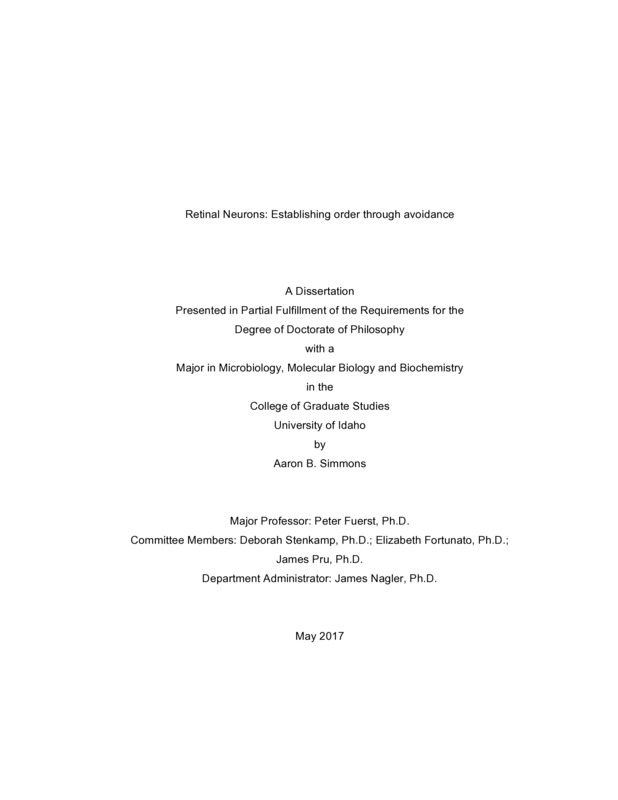Retinal Neurons: Establishing order through avoidance
Simmons, Aaron B.. (2017). Retinal Neurons: Establishing order through avoidance. Theses and Dissertations Collection, University of Idaho Library Digital Collections. https://www.lib.uidaho.edu/digital/etd/items/simmons_idaho_0089e_11081.html
- Title:
- Retinal Neurons: Establishing order through avoidance
- Author:
- Simmons, Aaron B.
- Date:
- 2017
- Embargo Remove Date:
- 2019-06-12
- Program:
- Biology
- Subject Category:
- Neurosciences; Cellular biology; Developmental biology
- Abstract:
-
Vision is the primary sense used by humans to interact with their surrounding world. Our sense of vision originates within the retina, a highly specialized projection of the central nervous system, which gathers sensory information in the form of light and then converts it into useful visual information before conveying it to the brain. The retina is composed of neurons, glia, and cells of the vasculature, all of which are highly organized within the retina. The work in this dissertation explores cellular interactions that are responsible for directing formation of this highly organized tissue and identifies novel neuron-vessel and neuron-neuron interactions that pertain to developmental and disease processes.
The first chapter explores how the neurons of the retina drive organization of the retinal vasculature. We find that the placement of neurons is important for the distribution of neural derived factors mediating vessel patterning. Disruptions in neural patterning lead to the misrepresentation of neural-derived factors resulting in fragile vessels that leak blood. The second chapter is a technical book chapter that outlines methodology used to measure retinal vessels in mouse models, providing a useful tool for researchers studying retinal vessel patterning.
The third chapter explores regulatory mechanisms that inhibit plasticity in mature neurons, an important factor limiting cell replacement therapies for retinal degenerative blinding disorders. We identify an important negative regulator of neuron plasticity, Down syndrome cell adhesion molecule (Dscam), and find it necessary for cellular interactions between neurons, resulting in inhibition of dendrite and axon outgrow. Elimination of Dscam in mature neurons stimulates dendrite and axon outgrowth and the formation of novel connections. The fourth chapter characterizes a transgenic mouse that was used to manipulate Dscam in mature neurons.
The work in this dissertation identifies important factors that drive vascular pathology that can result in retinal degenerative blinding disorders. Furthermore, this work identifies a potential therapeutic target that can be targeted to stimulate synaptogenesis allowing newly implanted cell populations to wire into existing circuits to restore vision.
- Description:
- doctoral, Ph.D., Biology -- University of Idaho - College of Graduate Studies, 2017
- Major Professor:
- Fuerst, Peter G
- Committee:
- Stenkamp, Deborah; Fortunato, Elizabeth; Pru, James
- Defense Date:
- 2017
- Identifier:
- Simmons_idaho_0089E_11081
- Type:
- Text
- Format Original:
- Format:
- application/pdf
- Rights:
- In Copyright - Educational Use Permitted. For more information, please contact University of Idaho Library Special Collections and Archives Department at libspec@uidaho.edu.
- Standardized Rights:
- http://rightsstatements.org/vocab/InC-EDU/1.0/

